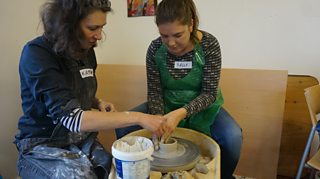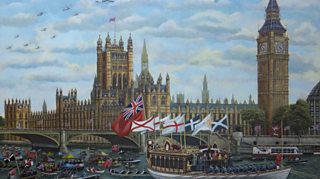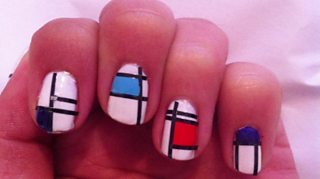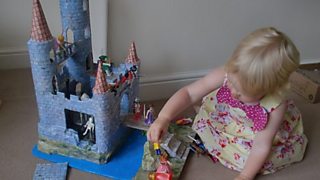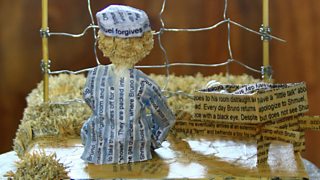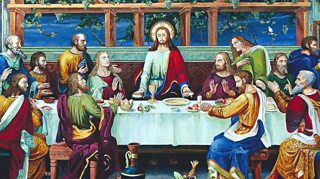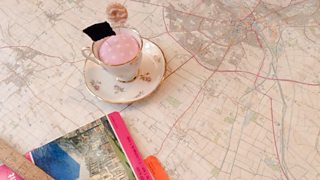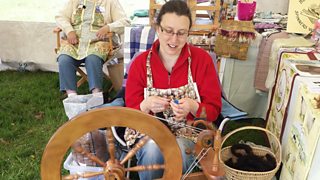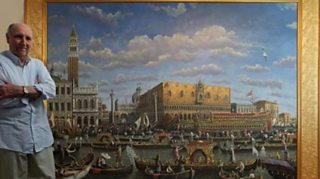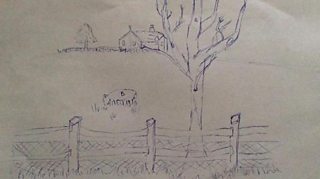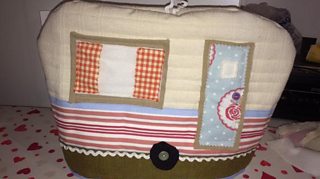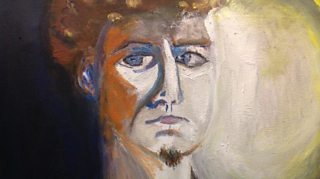The world traveller who never left home
American artist Joseph Cornell earned himself the title of 'armchair voyager' as he captured his dreams of far-away places in glass-fronted boxes without ever leaving his home city of New York. To celebrate an exhibition of his work at the Royal Academy, the Get Creative Champion is inviting us to share a 3D collage of our travel dreams and themes.
With artist friends and collaborators from Marcel Duchamp to Andy Warhol, Cornell was a major figure in the New York art scene from the 1930s onwards. But unlike his contemporaries, Cornell never left New York. Devoted to the care of his mother and brother, Cornell instead returned each day to the cluttered basement studio he worked from in Queens. It was crammed with boxes, files and tiny objects – stacks of feathers, piles of old pipes, shells, marbles, stamps and more – and it was from this eccentric collection that Cornell created some of the most original art of the 20th century. His magical shadow boxes are just one part of an unusual oeuvre that also included influential montage film and collage.
I collect anything of human interest. There are no elite kinds of things in my workJoseph Cornell
So what is a shadow box? Simple, glass-fronted, hinged display cases, "shadow boxes" have their origins in Victorian crafts. Throughout the 19th century, across Europe and America, it was a common hobby for women to fill these cases with keepsakes: shells, ships and dried flowers. They were sentimental objects, intended to preserve an atmosphere or a particular time or person.
Putting things in boxes – both bought boxes and later ones he constructed himself – first occurred to Cornell during his city jaunts in the 1930s. He would scour the dime stores and antique shops of Manhattan, looking for second-hand books and unusual objects to assemble; he bought buttons from haberdashery counters and coloured sand from pet shops. In an interview for Life magazine in 1967, Cornell said: “I collect anything of human interest. There are no elite kinds of things in my work.”
As the curator of the RA’s exhibition, Sarah Lea, explains: “Boxes allowed Cornell a structure to frame many poetic connections between disparate times, subjects and places that he sensed in the world. Given the extent of his collection, his shadow boxes are a really concise form of expression; the objects in the boxes take on metaphorical meanings.”
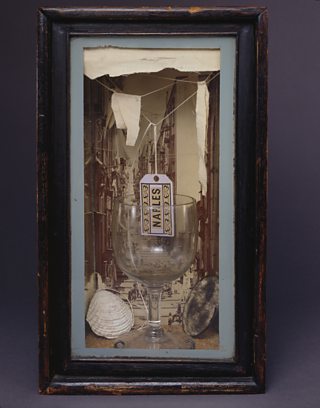
Through his shadow boxes, he travelled to distant realms, collecting imaginary souvenirs from imaginary voyages
Among an array of interests – which also included theatre and ballet, astronomy and nature – Cornell repeatedly returned to the idea of travel in his boxes, using words like “exploration” and “voyaging” to describe his work. He used fragments of maps, compasses, postage stamps and hotel advertisements of places he would never visit. Take Naples (1942), a narrow box containing a wine glass backed by a print of an Italian street scene, a microcosm of a distant city.
He was also interested in the freedom of birds to travel vast distances and in their migratory patterns – as in Habitat Group for a Shooting Gallery (1943), his interest in and knowledge of the natural world visible in his work. Through his shadow boxes, he travelled to distant realms, collecting imaginary souvenirs from imaginary voyages.
Cornell described himself as an “armchair voyager”. Through his assemblage of images and objects, he created faraway and exotic worlds in small wooden frames.
This article was written by Harriet Baker from the Royal Academy and a longer version appears on its website. Joseph Cornell: Wanderlust is at the RA from Saturday 4 July to 27 September. Organised by the Royal Academy of Arts, London in collaboration with the Kunsthistorisches Museum, Vienna.
Related Links
Advice from Royal Academicians
-
![]()
Get your teeth into #creativewisdoms
Artists such as Michael Craig-Martin, Cornelia Parker and Zaha Hadid help you get creative
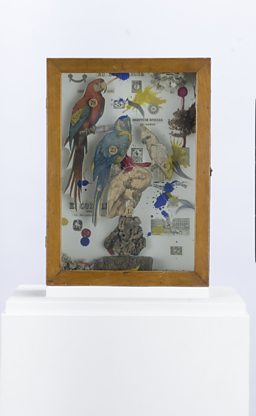
Be an armchair voyager
Now it’s your turn to be an armchair voyager. Inspired by Cornell, the Royal Academy is inviting artists and art-lovers to create a shadow box to reflect a place that means something to them.

Like Cornell, the key is to capture and explore the feel of the journey or place by assembling items – only you’ll be capturing them in a square photo format. Here’s an example of one representing a recent trip to Japan.
You could represent a past trip, or your box might be an imagined depiction of a place you’ve never been. You can assemble anything you like to represent the place; perhaps small souvenirs, tickets stubs, postcards, notes, imagery from magazines. To see more examples, including shadow boxes from Royal Academicians, search #CornellChallenge on Instagram.
Here’s what to do:
1. Think about your place and consider how you could evoke it visually. Start gathering items…
2. Assemble your items on a surface of your choice. Experiment with the look of your “box” until you’re happy that it represents your place.
3. Open Instagram (or choose the square setting on your smartphone camera) and take a photograph from above.
4. Post the picture on Instagram or other social media sites, tagging @royalacademyofarts and using the hashtag #Cornellchallenge.
We'll show a selection of the best and most interesting as chosen by the exhibition curator.
-
![]()
The Craft Club Yarnbombers
Meet the world-record holding crafters making a crochet Christmas project
-
![]()
Sally Taft
Get Creative's content producer rolls up her sleeves and threw a pot for Hey Clay!
-
![]()
Kenneth Small
The retired tool-maker who gave the Jubilee Thames Pageant sunny skies
-
![]()
Kate Simner
The contracts administrator with creativity at her fingertips
-
![]()
Kirk Crosby
DIY toymaker father creates kingdoms from clutter
-
![]()
Cindy Huntley
Paperback perfection: the school worker who sculpts art from stories
-
![]()
Patryk Sadowski
Photographer uses real life locations to create futuristic scenarios
-
![]()
Gary Cummins
Construction worker recreates day job in miniature
-
![]()
Anneka Gamble
Bake Off's back. How sugarcraft can be the icing on the cake.
-
![]()
Joe Whiteman
Landscape gardener has a monster talent
-
![]()
Jonathan Clark
Sports-mad poet serves ace verses
-
![]()
Neil Howard-Pritchard
How a lifeboat rescue sparked an interest in model boat making
-
![]()
Ron Hinkson
How a painter turned five church windows into a Renaissance masterpiece
-
![]()
Jean Samtula
One of a handful of aspiring artists whose painting was chosen for the Royal Academy's Summer Exhibition
-
![]()
David Martin
A retired designer who painted a Canaletto-style painting, replacing the buildings with those of his home town
-
![]()
Robert Burns
A retired decorator gave his home a Renaissance make-over
-
![]()
Maria Lyon
A crafter who loves creative challenges of all shapes and sizes
-
![]()
Rachel Blunden
A spinner who takes her spindles wherever she goes, including an FA Cup Semi-Final
-
![]()
Kenneth Small
A retired tool-maker who painted a life-size Canaletto replica
-
![]()
Bev Cain
A crafter who didn't think drawing would be her forte but had a go anyway
-
![]()
David Colbert
A former teacher who went looking for a hobby and found the ukulele
-
![]()
Emily Auger
A jewellery designer who discovered a love for digital printing and uses it as a way to relax and to cure jet-lag
-
![]()
Cheryl Lloyd
A dedicated mum and knitter who makes retro tank tops for her rugby- mad son and his friends to add a splash of style to the stands
-
![]()
Rachel Orchard
A stitcher who joined a sewing group to meet like-minded people. She's made tea cosies and draught excluders as gifts and hopes to move to dressmaking
-
![]()
Peter Egriega
A stroke survivor who has used painting, music and writing to rehabilitate. He shared his first self-portrait using his affected hand with Get Creative
-
![]()
Sally Taft
A keen cross stitcher and crafter who uses it as a way to relax and wind down after a day content producing for Get Creative


